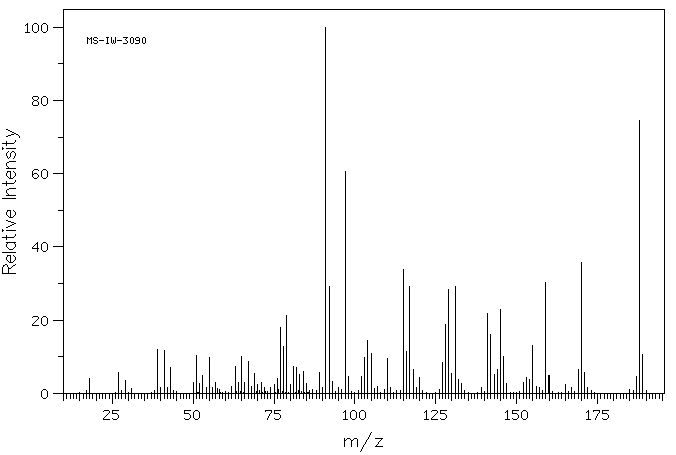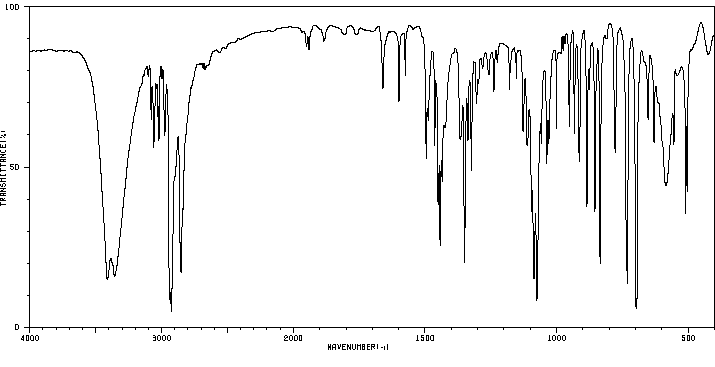2-benzylidenecyclohexanol | 34492-42-7
中文名称
——
中文别名
——
英文名称
2-benzylidenecyclohexanol
英文别名
2-hydroxybenzylidenecyclohexane;2-Benzyliden-cyclohexanol-(1);2-Benzylidenecyclohexan-1-ol
CAS
34492-42-7
化学式
C13H16O
mdl
——
分子量
188.269
InChiKey
ZKOAENWVLMOUPM-UHFFFAOYSA-N
BEILSTEIN
——
EINECS
——
-
物化性质
-
计算性质
-
ADMET
-
安全信息
-
SDS
-
制备方法与用途
-
上下游信息
-
文献信息
-
表征谱图
-
同类化合物
-
相关功能分类
-
相关结构分类
计算性质
-
辛醇/水分配系数(LogP):2.6
-
重原子数:14
-
可旋转键数:1
-
环数:2.0
-
sp3杂化的碳原子比例:0.38
-
拓扑面积:20.2
-
氢给体数:1
-
氢受体数:1
反应信息
-
作为反应物:描述:参考文献:名称:412.通过使用链烯基锂的链烯基化。第三部分 由异丁烯基锂合成不饱和酮摘要:DOI:10.1039/jr9500002012
-
作为产物:参考文献:名称:酰胺基硼烷锂,一种高度化学选择性的试剂,用于将α,β-不饱和酮还原为烯丙基醇†摘要:酰胺基硼烷锂(LiNH 2 BH 3,简称LiAB)在环境温度下能够将α,β-不饱和酮化学选择性还原为相应的烯丙基醇。机理研究表明,还原是通过双氢转移过程进行的。酰胺基硼烷中的质子H(N)和氢H(B)分别加到羰基的O和C位上。DOI:10.1039/c1ob06368e
文献信息
-
Tuning the Product Selectivity of the α-Alkylation of Ketones with Primary Alcohols using Oxidized Titanium Nitride Photocatalysts and Visible Light作者:Peifeng Li、Gang Xiao、Yilin Zhao、Haijia SuDOI:10.1021/acscatal.9b04921日期:2020.3.20α-alkylated ketones and enones is an attractive procedure for C–C bond formation. High reaction temperatures are always needed for heterogeneous catalysis using non-noble metals, and switching product selectivity in one catalysis system remains a great challenge. In the present study, a visible-light-driven procedure for this reaction is proposed, using oxidized TiN photocatalysts under mild conditions, whereby酮与醇直接进行α-烷基化反应以合成重要的α-烷基化的酮和烯酮是形成C-C键的诱人方法。对于使用非贵金属的多相催化,始终需要高反应温度,并且在一种催化体系中转换产物选择性仍然是一个巨大的挑战。在本研究中,提出了在可见光条件下使用氧化的TiN光催化剂对该反应进行可见光驱动的程序,从而可以很好地调节产物的选择性。通过低成本TiN纳米粉的简便灵活的热氧化处理,成功地合成了具有可调的表面N / O比的氧化TiN光催化剂。即使在室温下,苯乙酮与苯甲醇的α-烷基化反应仍会形成两个重要的化合物查耳酮和二氢查耳酮,在100°C的可见光下几乎可以完全转化。通过切换合成的光催化剂的表面N / O比率,可以很好地调节两种产物的比例。可见光会影响光催化剂的表面N / O比,并有助于调整产品的选择性。光强度和作用谱研究证明,基于TiN的带间跃迁或在TiO上形成的表面配合物的配体-金属电荷转移(LMCT)效应,高能电荷
-
Rhodium-Catalyzed Enantioselective Isomerization of Secondary Allylic Alcohols作者:Tang-Lin Liu、Teng Wei Ng、Yu ZhaoDOI:10.1021/jacs.7b01096日期:2017.3.15The first catalytic enantioselective isomerization of secondary allylic alcohols to access ketones with a α-tertiary stereocenter is presented. The racemic allylic alcohol substrates can be converted to the enantioenriched ketone products in a stereoconvergent fashion. The use of commercially available catalysts and mild reaction conditions makes this an attractive method in stereoselective synthesis
-
Copper(<scp>i</scp>) pyrimidine-2-thiolate cluster-based polymers as bifunctional visible-light-photocatalysts for chemoselective transfer hydrogenation of α,β-unsaturated carbonyls作者:Meng Juan Zhang、David James Young、Ji Long Ma、Guo Quan ShaoDOI:10.1039/d1ra01102b日期:——The photoinduced chemoselective transfer hydrogenation of unsaturated carbonyls to allylic alcohols has been accomplished using cluster-based MOFs as bifunctional visible photocatalysts. Assemblies of hexanuclear clusters [Cu6(dmpymt)6] (1, Hdmpymt = 4,6-dimethylpyrimidine-2-thione) as metalloligands with CuI or (Ph3P)CuI yielded cluster-based metal organic frameworks (MOFs) [Cu6(dmpymt)6]2[Cu2(μ-I)2]4(CuI)2}n使用基于簇的 MOF 作为双功能可见光催化剂已经完成了不饱和羰基到烯丙醇的光诱导化学选择性转移氢化。六核簇 [Cu 6 (dmpymt) 6 ] ( 1 , Hdmpymt = 4,6-二甲基嘧啶-2-硫酮) 作为金属配体与 CuI 或 (Ph 3 P)CuI 的组装产生基于簇的金属有机框架 (MOF) [ Cu 6 (dmpymt) 6 ] 2 [Cu 2 (μ-I) 2 ] 4 (CuI) 2 } n ( 2 ), [Cu 6 (dmpymt) 6 ] 2[Cu 2 (μ-I) 2 ] 4 } n ( 3 ),分别。2和3的纳米颗粒 (NPs)既可用作光敏剂,也可用作光催化剂,用于在蓝色 LED 照射下将不饱和羰基化合物高度化学选择性地还原为具有高催化活性的不饱和醇。光催化系统可以重复使用几个循环而没有任何明显的效率损失。
-
Dual Photoredox/Cobalt-Catalyzed Reductive Cyclization of Alkynals作者:Kento Nakamura、Hina Nishigaki、Yoshihiro SatoDOI:10.1021/acscatal.3c06206日期:2024.3.1alkynals using H2O for the catalyst turnover. This method was applied to aliphatic and aromatic aldehydes for five-, six-, and seven-membered (heterocyclic) ring formation with various substitutions on alkyne units. This H2O-added protocol was further developed into a one-pot transformation from acetals through in situ generated aldehydes, which shortened the synthetic path of the reaction.
-
Palladium-Catalyzed Enantioselective Oxidation of Chiral Secondary Alcohols: Access to Both Enantiomeric Series作者:David C. Ebner、Raissa M. Trend、Cédric Genet、Matthew J. McGrath、Peter O'Brien、Brian M. StoltzDOI:10.1002/anie.200801865日期:2008.8.11
表征谱图
-
氢谱1HNMR
-
质谱MS
-
碳谱13CNMR
-
红外IR
-
拉曼Raman
-
峰位数据
-
峰位匹配
-
表征信息
同类化合物
(βS)-β-氨基-4-(4-羟基苯氧基)-3,5-二碘苯甲丙醇
(S,S)-邻甲苯基-DIPAMP
(S)-(-)-7'-〔4(S)-(苄基)恶唑-2-基]-7-二(3,5-二-叔丁基苯基)膦基-2,2',3,3'-四氢-1,1-螺二氢茚
(S)-盐酸沙丁胺醇
(S)-3-(叔丁基)-4-(2,6-二甲氧基苯基)-2,3-二氢苯并[d][1,3]氧磷杂环戊二烯
(S)-2,2'-双[双(3,5-三氟甲基苯基)膦基]-4,4',6,6'-四甲氧基联苯
(S)-1-[3,5-双(三氟甲基)苯基]-3-[1-(二甲基氨基)-3-甲基丁烷-2-基]硫脲
(R)富马酸托特罗定
(R)-(-)-盐酸尼古地平
(R)-(-)-4,12-双(二苯基膦基)[2.2]对环芳烷(1,5环辛二烯)铑(I)四氟硼酸盐
(R)-(+)-7-双(3,5-二叔丁基苯基)膦基7''-[((6-甲基吡啶-2-基甲基)氨基]-2,2'',3,3''-四氢-1,1''-螺双茚满
(R)-(+)-7-双(3,5-二叔丁基苯基)膦基7''-[(4-叔丁基吡啶-2-基甲基)氨基]-2,2'',3,3''-四氢-1,1''-螺双茚满
(R)-(+)-7-双(3,5-二叔丁基苯基)膦基7''-[(3-甲基吡啶-2-基甲基)氨基]-2,2'',3,3''-四氢-1,1''-螺双茚满
(R)-(+)-4,7-双(3,5-二-叔丁基苯基)膦基-7“-[(吡啶-2-基甲基)氨基]-2,2”,3,3'-四氢1,1'-螺二茚满
(R)-3-(叔丁基)-4-(2,6-二苯氧基苯基)-2,3-二氢苯并[d][1,3]氧杂磷杂环戊烯
(R)-2-[((二苯基膦基)甲基]吡咯烷
(R)-1-[3,5-双(三氟甲基)苯基]-3-[1-(二甲基氨基)-3-甲基丁烷-2-基]硫脲
(N-(4-甲氧基苯基)-N-甲基-3-(1-哌啶基)丙-2-烯酰胺)
(5-溴-2-羟基苯基)-4-氯苯甲酮
(5-溴-2-氯苯基)(4-羟基苯基)甲酮
(5-氧代-3-苯基-2,5-二氢-1,2,3,4-oxatriazol-3-鎓)
(4S,5R)-4-甲基-5-苯基-1,2,3-氧代噻唑烷-2,2-二氧化物-3-羧酸叔丁酯
(4S,4''S)-2,2''-亚环戊基双[4,5-二氢-4-(苯甲基)恶唑]
(4-溴苯基)-[2-氟-4-[6-[甲基(丙-2-烯基)氨基]己氧基]苯基]甲酮
(4-丁氧基苯甲基)三苯基溴化磷
(3aR,8aR)-(-)-4,4,8,8-四(3,5-二甲基苯基)四氢-2,2-二甲基-6-苯基-1,3-二氧戊环[4,5-e]二恶唑磷
(3aR,6aS)-5-氧代六氢环戊基[c]吡咯-2(1H)-羧酸酯
(2Z)-3-[[(4-氯苯基)氨基]-2-氰基丙烯酸乙酯
(2S,3S,5S)-5-(叔丁氧基甲酰氨基)-2-(N-5-噻唑基-甲氧羰基)氨基-1,6-二苯基-3-羟基己烷
(2S,2''S,3S,3''S)-3,3''-二叔丁基-4,4''-双(2,6-二甲氧基苯基)-2,2'',3,3''-四氢-2,2''-联苯并[d][1,3]氧杂磷杂戊环
(2S)-(-)-2-{[[[[3,5-双(氟代甲基)苯基]氨基]硫代甲基]氨基}-N-(二苯基甲基)-N,3,3-三甲基丁酰胺
(2S)-2-[[[[[((1S,2S)-2-氨基环己基]氨基]硫代甲基]氨基]-N-(二苯甲基)-N,3,3-三甲基丁酰胺
(2S)-2-[[[[[[((1R,2R)-2-氨基环己基]氨基]硫代甲基]氨基]-N-(二苯甲基)-N,3,3-三甲基丁酰胺
(2-硝基苯基)磷酸三酰胺
(2,6-二氯苯基)乙酰氯
(2,3-二甲氧基-5-甲基苯基)硼酸
(1S,2S,3S,5S)-5-叠氮基-3-(苯基甲氧基)-2-[(苯基甲氧基)甲基]环戊醇
(1S,2S,3R,5R)-2-(苄氧基)甲基-6-氧杂双环[3.1.0]己-3-醇
(1-(4-氟苯基)环丙基)甲胺盐酸盐
(1-(3-溴苯基)环丁基)甲胺盐酸盐
(1-(2-氯苯基)环丁基)甲胺盐酸盐
(1-(2-氟苯基)环丙基)甲胺盐酸盐
(1-(2,6-二氟苯基)环丙基)甲胺盐酸盐
(-)-去甲基西布曲明
龙蒿油
龙胆酸钠
龙胆酸叔丁酯
龙胆酸
龙胆紫-d6
龙胆紫








